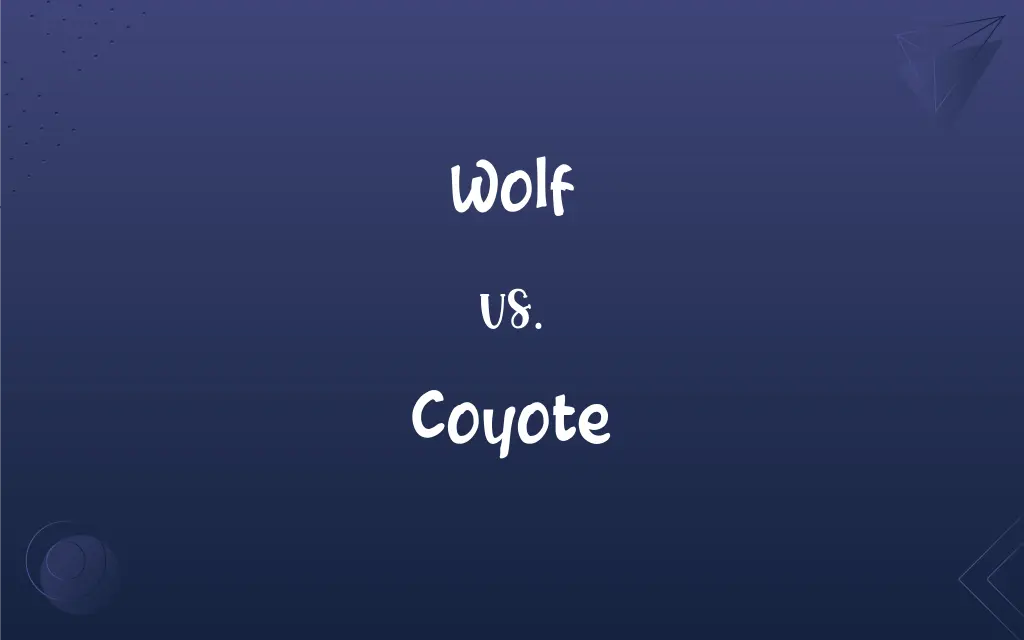Wolf vs. Coyote: What's the Difference?
Edited by Janet White || By Harlon Moss || Updated on October 24, 2023
A wolf is a larger, wild canine known for its pack behavior, while a coyote is a smaller, more solitary and adaptable wild canine.

Key Differences
Wolf and coyote are both wild canines, but they differ significantly in size, behavior, and habitat. The wolf is notably larger, often weighing between 70 to 150 pounds, and is characterized by its pack-oriented behavior. In contrast, the coyote is smaller, typically weighing 20 to 50 pounds, and while they can form packs, they're often seen as solitary creatures.
In terms of appearance, the wolf has a broader snout and larger feet, complementing its bigger size. Its coat can vary in color but often exhibits a mix of grays, browns, and whites. The coyote, on the other hand, generally has a slimmer face and smaller feet. Its fur is typically tan or grayish-brown, with a bushy tail often marked with a black tip.
The habitats of the wolf and coyote also differ. Historically, wolves roamed vast territories across North America, Europe, and Asia. Due to human activity, their range has decreased, but they still inhabit forests, tundras, and grasslands. The coyote, conversely, is highly adaptable and can thrive in various environments, from deserts to urban areas.
While both the wolf and coyote are carnivorous predators, their diets and hunting strategies differ. Wolves, being pack animals, often hunt larger prey like elk, deer, and bison. They employ teamwork to bring down these animals. Coyotes, being smaller and more solitary, primarily hunt smaller mammals but are known for their opportunistic nature, often scavenging or eating fruits and vegetables.
Both wolf and coyote have cultural significance in various societies. The wolf is often symbolized as a fierce and loyal creature in many legends and myths. The coyote, particularly in Native American tales, is frequently depicted as a clever trickster, showcasing its adaptable and cunning nature.
ADVERTISEMENT
Comparison Chart
Size
Larger (70-150 lbs)
Smaller (20-50 lbs)
Appearance
Broader snout, larger feet, varied coat colors
Slimmer face, smaller feet, tan/grayish coat with bushy tail
Habitat
Forests, tundras, grasslands
Deserts to urban areas
Diet
Hunts larger prey like elk, deer
Smaller mammals, opportunistic, omnivorous
Cultural Significance
Often symbolized as fierce and loyal
Seen as a clever trickster
ADVERTISEMENT
Wolf and Coyote Definitions
Wolf
A large wild canine known for its pack behavior.
The wolf howled, signaling its pack to gather.
Coyote
A smaller wild canine, adaptable and often solitary.
The coyote's yip echoed through the desert night.
Wolf
A predator native to North America, Europe, and Asia.
The wolf's range has diminished due to human encroachment.
Coyote
An opportunistic feeder, eating small mammals and even fruits.
The coyote scavenged the leftovers from the campsite.
Wolf
A symbol of loyalty and fierceness in various cultures.
In many tales, the wolf is portrayed as a guardian spirit.
Coyote
A predator primarily native to North America.
Coyotes have expanded their range, even reaching urban areas.
Wolf
An apex predator hunting large prey like elk and deer.
The wolf pack worked together to bring down the deer.
Coyote
A mammal with a tan or grayish coat and a bushy tail.
The distinctive black tip on the coyote's tail made it easily identifiable.
Wolf
A mammal with a varied coat, often gray, brown, and white.
The beauty of the wolf's fur was evident under the moonlight.
Coyote
Often depicted as a trickster in Native American folklore.
The tale spoke of the coyote outsmarting larger animals.
Wolf
Any of several carnivorous mammals of the genus Canis, especially the gray wolf of northern regions, that typically live and hunt in packs.
Coyote
A wolflike carnivorous mammal (Canis latrans) of North and Central America, having grayish-brown or yellowish fur, large erect ears, and a drooping bushy tail. Also called prairie wolf.
FAQs
What is a coyote?
A coyote is a smaller, adaptable wild canine, often seen as solitary and opportunistic.
Where are wolves found?
Wolves are native to North America, Europe, and Asia, inhabiting forests, tundras, and grasslands.
Which is larger, a wolf or a coyote?
A wolf is generally larger than a coyote.
Where do coyotes live?
Coyotes primarily live in North America and can thrive in diverse environments, from deserts to cities.
Do wolves and coyotes live in packs?
While wolves are known for their pack behavior, coyotes can be both solitary and form packs.
What do wolves eat?
Wolves primarily hunt larger prey like elk, deer, and bison.
How do the appearances of wolves and coyotes differ?
Wolves have a broader snout, larger feet, and a varied coat color, while coyotes have a slimmer face, smaller feet, and a tan or grayish coat.
How do coyotes survive in diverse habitats?
Their adaptable nature, varied diet, and opportunistic behavior help them thrive in various environments.
What is a wolf?
A wolf is a large wild canine known for its pack behavior and hunting large prey.
How fast can a wolf run?
Wolves can reach speeds of up to 35-40 mph in short bursts.
How have humans impacted the populations of wolves and coyotes?
Human activity has decreased wolf populations, but coyotes have adapted and even expanded their range in response to human encroachment.
What is the diet of a coyote?
Coyotes eat smaller mammals, but they're opportunistic and can also eat fruits and scavenge.
Do coyotes have cultural significance?
Yes, especially in Native American folklore, where the coyote is often depicted as a trickster.
Do wolves and coyotes interbreed?
Yes, they can interbreed, producing what's known as a "coywolf" or "eastern coyote."
What sounds do coyotes make?
Coyotes are known for their yips, howls, and barks.
How does the pack structure of wolves work?
Wolf packs have a hierarchy with an alpha pair leading and other members having specific roles.
Are coyotes adaptable to urban areas?
Yes, coyotes are highly adaptable and can live in urban environments.
How do wolves communicate?
Wolves use vocalizations, body language, and scent marking to communicate.
Are wolves endangered?
Some wolf subspecies are endangered due to habitat loss and persecution.
Are coyotes dangerous to humans?
While coyotes are generally wary of humans, conflicts can arise, especially if they become habituated to human presence.
About Author
Written by
Harlon MossHarlon is a seasoned quality moderator and accomplished content writer for Difference Wiki. An alumnus of the prestigious University of California, he earned his degree in Computer Science. Leveraging his academic background, Harlon brings a meticulous and informed perspective to his work, ensuring content accuracy and excellence.
Edited by
Janet WhiteJanet White has been an esteemed writer and blogger for Difference Wiki. Holding a Master's degree in Science and Medical Journalism from the prestigious Boston University, she has consistently demonstrated her expertise and passion for her field. When she's not immersed in her work, Janet relishes her time exercising, delving into a good book, and cherishing moments with friends and family.







































































